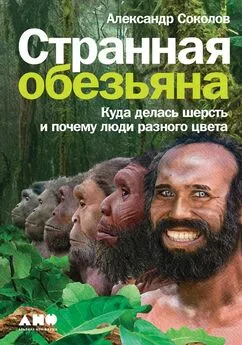Александр Соколов - Странная обезьяна [Куда делась шерсть и почему люди разного цвета]
- Название:Странная обезьяна [Куда делась шерсть и почему люди разного цвета]
- Автор:
- Жанр:
- Издательство:Альпина нон-фикшн
- Год:2020
- Город:Москва
- ISBN:978-5-0013-9316-0
- Рейтинг:
- Избранное:Добавить в избранное
-
Отзывы:
-
Ваша оценка:
Александр Соколов - Странная обезьяна [Куда делась шерсть и почему люди разного цвета] краткое содержание
Об этом и многом другом рассказывает в своей книге редактор портала АНТРОПОГЕНЕЗ.РУ Александр Соколов, еще раз доказывая, что наука — это потрясающе интересно и порой парадоксально.
Странная обезьяна [Куда делась шерсть и почему люди разного цвета] - читать онлайн бесплатно ознакомительный отрывок
Интервал:
Закладка:
18. Thompson C. W., Hillgarth N., Leu M., and Mcclure H. E. High Parasite Load in House Finches (Carpodacus Mexicanus). Is Correlated with Reduced Expression of A Sexually Selected Trait // American Naturalist (Feb 1997), 149 (2).
19. Moller A. P., Christe P. and Lux E. Parasitism, Host Immune Function, and Sexual Selection // Quarterly Review of Biology (Mar 1999), 74 (1).
20. Schalk G. and Forbes M. R. Male Biases in Parasitism of Mammals: Effects of Study Type, Host Age, and Parasite Taxon // Oikos (Feb 1997), 78 (1): 67–74.
21. Prokop P., Rantala M. J., Usak M., Senay I. Is a Woman’s Preference for Chest Hair in Men Influenced by Parasite Threat? // Archives of Sexual Behavior (2013), 42: 1181–1189.
22. Rantala M. J., Pölkki M., Rantala L. M. Preference for Human Male Body Hair Changes Across the Menstrual Cycle and Menopause // Behavioral Ecology (Mar — Apr 2010), 21 (2): 419–423.
23. Prokop P., Rantala M. J., Usak M., Senay I. Is a Woman’s Preference for Chest Hair in Men Influenced by Parasite Threat? // Archives of Sexual Behavior (2013), 42: 1181–1189.
24. Stephens P. R., Pappalardo P., Huang S., Byers J. E., Maxwell J., Farrell M. J., Gehman A., Ghai R. R., Haas S. E., Han B., Park A. W. Global Mammal Parasite Database Version 2.0 // Ecology (May 2017), 98 (5): 1476–1476.
25. Reed D. L., Light J. E., Allen J. M., and Kirchman J. J. Pair of Lice Lost or Parasites Regained: the Evolutionary History of Anthropoid Primate Lice // BMC Biology (2007), 5: 7.
26. Weiss R. A. Apes, Lice and Prehistory // Journal of Biology (2009), 8: 20.
Глава 7. Как дети
1. Ashley M. F. Time, Morphology, and Neoteny in the Evolution of Man // American Anthropologist , New Series (Feb 1955), 57 (1): 13–27.
2. Gould S. J. Ontogeny and Phylogen. Belknap Press of Harvard University Press, 1977.
3. Там же.
4. Bolk L. The Part Played by the Endocrine Glands in the Evolution of Man // Lancet (Sept 10), 1921.
5. Bolk L. On the Problem of Anthropogenesis // Proceedings Royal Acad (1925), Vol. XXIX.
6. Там же.
7. Там же.
8. Ashley M. F. Time, Morphology, and Neoteny in the Evolution of Man // American Anthropologist , New Series (Feb 1955), 57 (1): 13–27.
9. Лоренц К. Восемь смертных грехов цивилизованного человечества // Фет А. И. Собрание переводов, Philosophical arkiv, Sweden, 2016.
10. Gould S. J. Ontogeny and Phylogen. Belknap Press of Harvard University Press, 1977.
11. Penin X., Berge C., and Baylac M. Ontogenetic Study of the Skull in Modern Humans and the Common Chimpanzees: Neotenic Hypothesis Reconsidered with a Tridimensional Procrustes Analysis // American Journal of Physical Anthropology (2002), 118: 50–62.
12. Bufill E., Agusti J., and Blesa R. Human Neoteny Revisited: The Case of Synaptic Plasticity // American Journal of Human Biology (2011), 23: 729–739.
13. Bufill E., Agusti J., and Blesa R. Human Neoteny Revisited: The Case of Synaptic Plasticity // American Journal of Human Biology (2011), 23: 729–739.
14. Shea B. T. Heterochrony in Human Evolution: The Case for Neoteny Reconsidered // Yearbook of Physical Anthropology (1989), 32: 69–101.
15. Steven R. Leigh and Paul B. Park. Evolution of Human Growth Prolongation // American Journal of Physical Anthropology (1998), 107: 331–350.
16. Боринская С. А., Янковский Н. К., Козлов А. И. Гены и традиции питания. Часть I // АНТРОПОГЕНЕЗ.РУ. 2011. http://antropogenez.ru/article/293/.
17. Somel M., Franz H., Yan Z., Lorenc A., Guo S., Giger T., Kelso J., Nickel B., Dannemann M., Bahn S., Webster M. J., Weickert C. S., Lachmann M., Paabo S., and Khaitovich P. Transcriptional Neoteny in the Human Brain // PNAS (Apr 2009), 106 (14).
18. Skulachev V. P., Holtze S., Vyssokikh M. Y., Bakeeva L. E., Skulachev M. V., Markov A. V., Hildebrandt T. B., and Sadovnichii V. A. Neoteny, Prolongation of Youth: From Naked Mole Rats to «Naked Apes» (Humans) // Physiological Reviews (2017): 699–720.
19. Kim E. B., Fang X., et al. and Gladyshev V. N. Genome Sequencing Reveals Insights into Physiology and Longevity of The Naked Mole Rat // Nature (2011), 479: 223–227.
20. Ahmad W., Faiyaz M. H. ul, Brancolini V., Tsou H. C., Haque S. ul, Lam HaMut, Aita V. M. Alopecia Universalis Associated with a Mutation in the Human hairless Gene // Science (Jan 1998), 279 (5351): 720–724.
Глава 8. Восхождение гидропитека
1. Westenhöfer M. Der Eigenweg des Menschen. Dargestellt auf Grund von vergleichend morphologischen Untersuchungenüber die Artbildung und Menschwerdung. Berlin: Verlagder Medizinischen Welt, W. Mannstaedt & Co, 1942.
2. Hardy A. Was there a Homo aquaticus? // Zenith (1977), 15 (1): 4–6.
3. Там же.
4. Моррис Д. Голая обезьяна. — М.: КоЛибри, 2018.
5. Morgan E. The Descent of Woman. Souvenir Press, 1972.
6. Там же.
7. Morgan E. I Believe We Evolved from Aquatic Apes // TEDGlobal 2009. https://www.ted.com/talks/elaine_morgan_i_believe_we_evolved_from_aquatic_apes.
8. Ashford R. W. Parasites as Indicators of Human Biology and Evolution // Journal of Medical Microbiology (2000), 49 (9): 771–772.
9. Линдблад Я. Человек — ты, я и первозданный. — М.: Прогресс, 1991.
10. Wheeler P. E. The Loss of Functional Body Hair in Man: the Influence of Thermal Environment, Body Form and Bipedality // Journal of Human Evolution (1985), 14: 23–28.
11. Дробышевский С. В. Как возникло прямохождение? // Достающее звено. АНТРОПОГЕНЕЗ.РУ. 2010. http://antropogenez.ru/zveno-single/20/.
12. Утопления // ВОЗ. 3.02.2020. https://ww.who.int/ru/news-room/fact-sheets/detail/drowning.
13. McGraw M. B. Swimming Behavior of the Human Infant // Journal of Pediatrics (1939), 15 (4): 486.
14. Langdon J. H. Umbrella Hypotheses and Parsimony in Human Evolution: A Critique of the Aquatic Ape Hypothesis // Journal of Human Evolution (1997), 33: 479–494.
15. Дробышевский С. В. Ардипитек рамидус // Достающее звено. АНТРОПОГЕНЕЗ.РУ. 2010. http://antropogenez.ru/zveno-single/57/.
16. Niemitz C. The Evolution of the Upright Posture and Gait — a Review and a New Synthesis // Naturwissenschaften (2010), 97: 241–263.
Глава 9. В поте лица твоего
1. Cramer W. Fever, Heat Regulation, Climate, and the Thyroidadrenal Apparatus. Longmans, Green and Co. Ltd., 1928.
2. Lieberman D. E. Human Locomotion and Heat Loss: An Evolutionary Perspective // Evolution of Human Locomotion and Heat Loss (Jan 2015), Vol. 5.
3. Campbell B. G. Human Evolution. An Introduction to Man’s Adaptations. Aldine Publishing Company, Chicago, 1966.
4. Zihlman A. L., Cohn B. A. The Adaptive Response of Human Skin to the Savanna // Human Evolution (1988), 3 (5): 397–409.
5. Там же.
6. Szabo G. The Regional Anatomy of the Human Integument with Special Reference to the Distribution of Hair Follicles, Sweat Glands and Melanocytes // Philosophical Transactions of the Royal Society London. B (1967), No. 779: 252, 447–485.
7. Lieberman D. E. Human Locomotion and Heat Loss: An Evolutionary Perspective // Evolution of Human Locomotion and Heat Loss (Jan 2015), Vol. 5.
8. Montagna W. and Yun J. S. The Skin of Primates Xv. The Skin of the Chimpanzee (Pan satyrus) // American Journal of Physical Anthropology (June 1963), 21 (2): 189–203.
9. Hiley P. G. The Thermoregulatory Responses of the Galago (Galago Crassicaudatus), the Baboon (Papio Cynocephalus) and the Chimpanzee (Pan Satyrus) to Heat Stress // Journal of Physiology (1976), 254: 657–671.
10. Zurovsky Y., Shkolnik A. Water Economy and Body Fluid Distribution in the Hamadryas Baboon (Papio Hamadryas) // Journal of Thermal Biology (1993), 18 (3): 153–157.
11. Newman R. W. Why Man is Such a Sweaty and Thirsty Naked Animal: A Speculative Review // Human Biology (Feb 1970), 42 (1): 12–27.
12. Mahoney S. A. Cost of Locomotion and Heat Balance during Rest and Running from 0 to 55 °C in a Patas Monkey // Journal of Applied Physiology: Respirat. Environ. Exercise Physiol (1980), 49 (5): 789–800.
13. Newman R. W. Why Man is Such a Sweaty and Thirsty Naked Animal: A Speculative Review // Human Biology (Feb 1970), 42 (1): 12–27.
14. Schmidt-Nielsen K. The Physiology of the Camel // Scientific American (Dec 1959), 201: 140–51. https://www.ncbi.nlm.nih.gov/pubmed/14443122.
15. Coon C. S. Some Problems of Human Variability and Natural Selection in Climate and Culture // American Naturalist (Sept — Oct 1955), 89 (848): 257–279.
16. Hockett C. F. and Ascher R. The Human Revolution // Current Anthropology (June 1964), 5 (3).
17. Campbell B. G. Human Evolution. An Introduction to Man’s Adaptations. Aldine Publishing Company, Chicago, 1966.
18. Newman R. W. Why Man is Such a Sweaty and Thirsty Naked Animal: A Speculative Review // Human Biology (Feb 1970), 42 (1): 12–27.
19. Lee D. H. K. Studies of Heat Regulation in the Sheep, with Special Reference to the Merino // Australian Journal of Agricultural Research (Jan 1950), 1 (2).
20. Bramble D. M. and Lieberman D. E. Endurance Running and the Evolution of Homo // Nature (Nov 2004), 432: 345–352.
21. Lieberman D. E. Human Locomotion and Heat Loss: An Evolutionary Perspective // Evolution of Human Locomotion and Heat Loss (Jan 2015), Vol. 5.
Читать дальшеИнтервал:
Закладка:
![Обложка книги Александр Соколов - Странная обезьяна [Куда делась шерсть и почему люди разного цвета]](/books/1066936/aleksandr-sokolov-strannaya-obezyana-kuda-delas-sh.webp)






